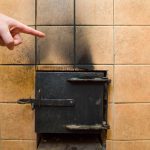How To Get Soot Off Walls
Soot comes from fireplaces, candles, and even house fires, and leaves ugly stains on all materials or surfaces it encounters. Soot's acidic nature makes it difficult to remove from walls, so removing it requires specific techniques and tools. Do not begin scrubbing without the proper materials or techniques, or you will likely make things worse. If your home is affected by soot, you need to call a fire damage restoration professional that is trained and equipped to clean up soot damage.
How Soot Causes Damage
Soot is composed of leftover particles of carbon from incomplete combustion and is a corrosive byproduct of fires. Soot and smoke may appear as an oily film or dry powder, and its color ranges from light grey to black. Regardless of how it appears, soot particles are highly acidic, and its electrostatic attraction causes it to cling to walls. Soot can spread so quickly because it is four times smaller than a dust particle. Soot's high acidity levels cause it to quickly leave thick, black stains on affected surfaces.
Affected Surfaces
Soot and smoke particles attach themselves to the following surfaces:
• Hardwood floors
• Wooden furniture and cabinets
• Exposed wood beams
• Ceilings
• Walls (drywall and plaster)
Materials
In order to effectively remove soot stains, you will need the proper cleaning equipment. These materials include:
• Dry cleaning sponge, also known as a chemical sponge, a soot remover sponge, or a wall brite sponge. These sponges are designed to work best when dry and do not contain any actual chemicals, despite their nickname. They get dirty during cleanup, so simply cut away the stained portion and continue cleaning.
• Degreaser and other household cleaners are often used to remove oilier, thicker soot stains. Degreasers are most effective on painted surfaces and walls, although they work on wood well. However, avoid gritty cleaners because it may scratch the paint and wood.
• Gloves will keep your hands clean and free of stains during the soot removal process. They will also prevent you from smelling like the cleaning solutions you will be using.
• Clean cloths/rags are helpful when applying or removing cleaners. Both dry and wet cloths should be available during the soot removal process, as both have different functions. Dry cloths are better at wiping away soot residue and wet cloths typically clean soot better.
• Bucket will hold the cleaning agent.
• Vacuum, more specifically a shop vac with a hose, is the best tool for removing soot because it has a large capacity and is designed for high suction. However, a regular vacuum with a wand or hose attachment will also work. You should thoroughly clean the wand afterward if you do choose to use a regular vacuum.
Soot Removal Process
Before you begin, be sure to wear proper attire, a mask, and gloves because soot can irritate your skin and lungs. You must also take care to prevent spreading the soot during the removal process, especially if it covers a large area. Cover any surface or object that isn't currently damaged by soot and move all furniture into a different room.
First, use a vacuum with an attached upholstery brush in order to remove loose soot particles. Vacuum the affected surfaces and lightly use the brush to remove soot.
Next, use a dry-cleaning (or chemical) sponge to carefully wipe the remaining soot. Do not wipe with water or soot cleaner first because this will spread the soot and you will be unable to remove it with a dry-cleaning sponge. Chemical sponges consist of special materials that lift stains from the wall. Once your sponge is covered with soot, use the clean side or replace the sponge. Use a wiping motion, not a scrubbing motion, to avoid working the stains deeper into the surface.
Next, use the degreaser to carefully wash the surface. Follow the directions on the label and use the same wiping motion you used with the dry-cleaning sponge. As your rag or cloth gets dirty, wring it out in the bucket and continue cleaning. Afterward, replace the contents of the bucket with fresh water and use a clean rag to wipe down the walls. Then, use another clean rag to dry the walls and allow it to dry.
Contact Us
Soot removal is a manageable job if only a small area is damaged, but a large area can be challenging for inexperienced homeowners. Trains professionals with years of experience in fire damage restoration and soot removal can clean and restore household objects affected by smoke and soot. We will handle the cleanup while you and your family recover from the traumatic event.
About Luke Armstrong
Expert in emergency fire and water restoration services, fire cleanup and water damage cleanup, mold removal, as well as carpet and upholstery cleaning services. Contributor to several restoration and cleaning blogs.
How To Get Soot Off Walls
Source: https://restorationmasterfinder.com/restoration/remove-soot-damage-walls/
Posted by: mcdanielpridn1990.blogspot.com

0 Response to "How To Get Soot Off Walls"
Post a Comment